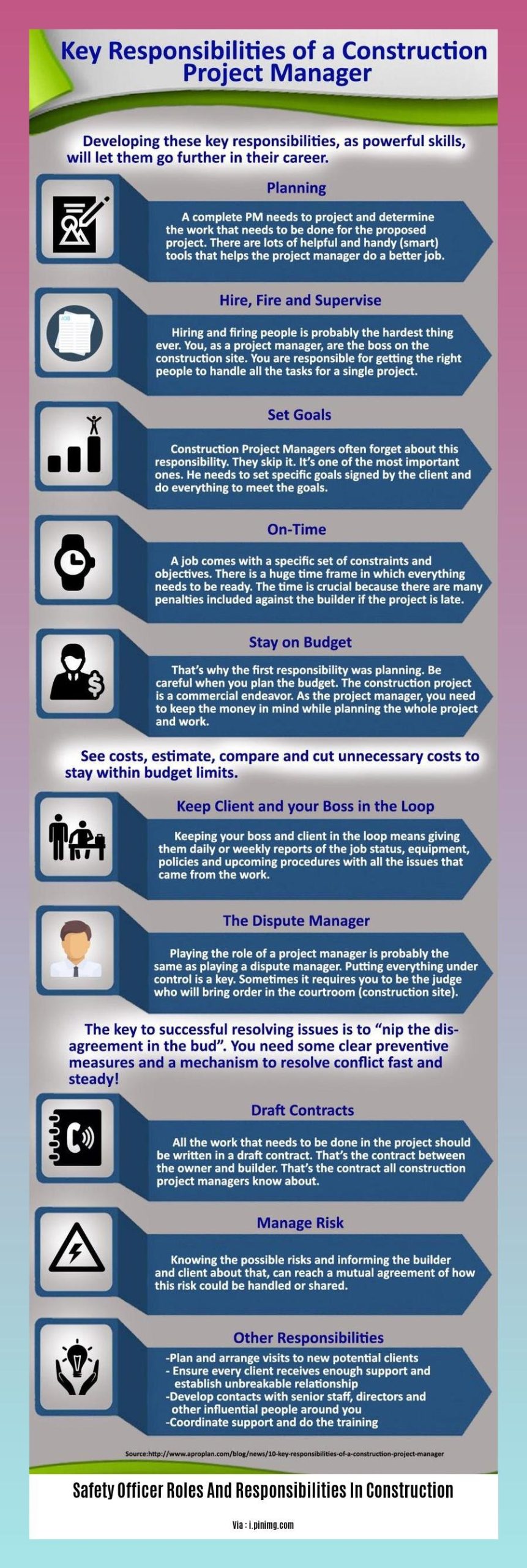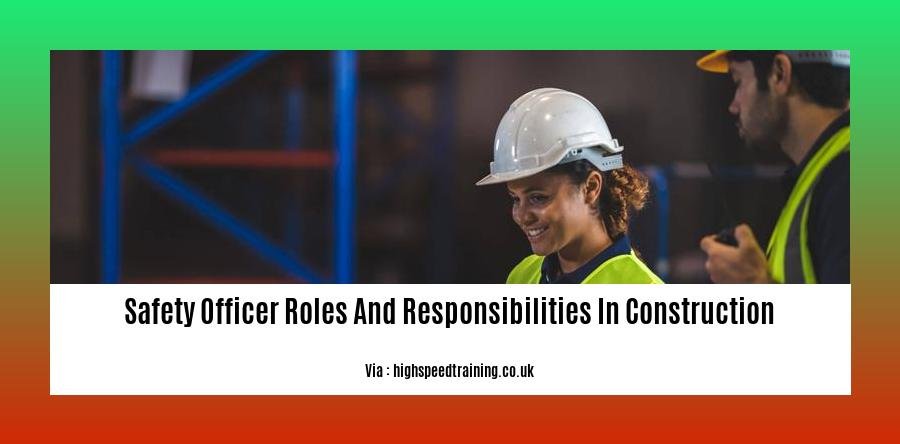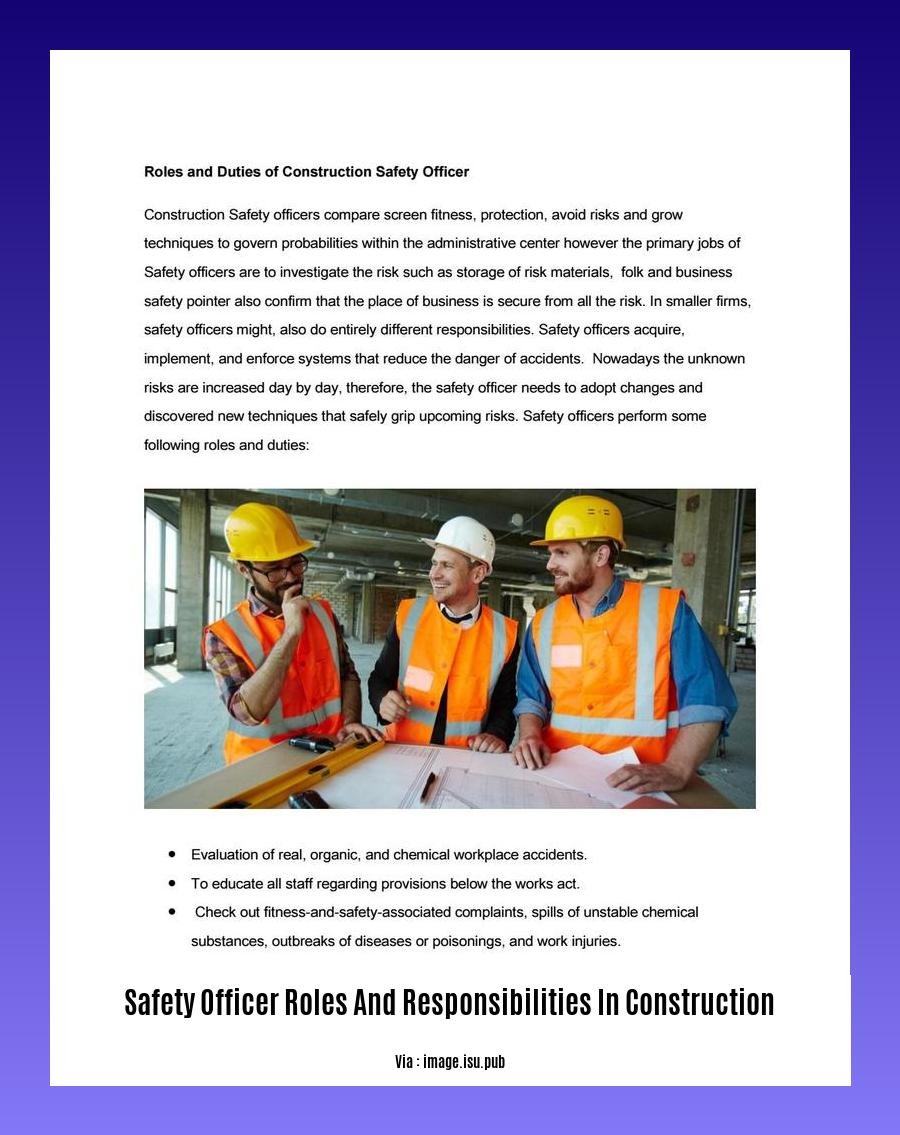–
Key Takeaways:
- Ensure the well-being of workers and visitors on construction sites.
- Develop and enforce safety policies to reduce accident risks.
- Conduct site inspections to identify and assess potential hazards.
- Educate workers on safety procedures and standards.
- Investigate accidents and injuries that occur on-site.
- Maintain safety activity and incident records and reports.
- Uphold compliance with all relevant health and safety regulations.
Safety Officer Roles and Responsibilities in Construction

As safety officers in construction, we play a critical role in safeguarding construction sites and ensuring the safety of everyone working on them. Our responsibilities are extensive and require a deep understanding of safety procedures and regulations.
One of our primary duties is to develop and implement safety policies and procedures that reduce the risk of accidents. This involves conducting thorough site inspections and risk assessments to identify potential hazards and developing plans to mitigate them.
We also provide comprehensive safety training to workers on site, ensuring they are well-versed in safety protocols and aware of any potential risks they may face. By regularly monitoring and enforcing safety measures, we create a culture of safety consciousness among workers.
In the unfortunate event of an accident or injury, we conduct prompt investigations to determine the root cause and implement preventive measures to prevent similar incidents from occurring in the future. We also ensure that all records and reports related to safety activities and incidents are meticulously maintained.
Additionally, we work closely with project managers and contractors to ensure compliance with all relevant health and safety regulations. Our knowledge of industry best practices and legal requirements helps ensure construction projects are completed safely and efficiently.
Essential Roles
- Ensuring Workers’ Safety: Identifying hazards, implementing safety measures, and enforcing protocols to minimize the risk of accidents and injuries.
- Creating a Culture of Safety: Providing training and encouraging safe work practices to instill a safety-conscious mindset among workers.
- Preventing Accidents: Conducting regular inspections, assessing risks, and developing plans to proactively prevent accidents from occurring.
- Protecting Against Legal Liabilities: Ensuring compliance with safety regulations and implementing measures to reduce the potential for accidents and legal issues.
Overall, the roles and responsibilities of safety officers in construction are crucial for ensuring a safe work environment and protecting the well-being of all those involved in construction projects.
For additional guidance on the roles and responsibilities of a safety officer in a construction company, safety officer in construction company offers insightful details and best practices.
If you’re preparing for an interview as a safety officer in construction, safety officer interview questions and answers in construction provides invaluable insights to help you ace the process.
To delve deeper into the safety officer’s responsibilities, safety officer responsibilities in construction outlines the full scope of their duties and how they contribute to a safe work environment.
Finally, for an innovative approach to construction site safety training, safety park in construction site showcases how interactive simulation environments can enhance safety awareness and reduce risks.
Explain the Importance of Safety Officers and Regulations
Safety Officers and Regulations are the backbone of any construction project. They ensure that workers are safe, that the worksite is compliant with all applicable laws and regulations, and that the project is completed on time and within budget.
Without them, construction sites would be much more dangerous places, and workers would be at risk of serious injury or even death.
There are many different types of Safety Officers, each with their own specific responsibilities. Some Safety Officers are responsible for conducting safety inspections, while others are responsible for training workers on safety procedures. Still others are responsible for investigating accidents and developing safety plans.
No matter what their specific responsibilities are, all Safety Officers play a vital role in keeping construction sites safe. They help to ensure that workers are aware of the hazards they face, that they are trained to work safely, and that they have the equipment they need to protect themselves.
Regulations are also essential for keeping construction sites safe. These regulations set out the minimum safety standards that must be met by all construction companies. They cover a wide range of topics, including:
- Worker training
- Hazard identification and assessment
- Personal protective equipment
- Emergency preparedness
- Fall protection
- Scaffolding
- Excavation
By following these regulations, construction companies can help to ensure that their workers are safe and that their projects are completed safely and efficiently.
Key Takeaways:

- Safety Officers help to ensure that construction sites are safe for workers.
- Regulations set out the minimum safety standards that must be met by all construction companies.
- Both Safety Officers and regulations are essential for keeping construction sites safe.
Relevant URL Sources:
– Construction Safety Officer: Duties & Requirements
– The Safety Officer: Essential Duties, Responsibilities, and Importance
Highlight the impact of a Safety Officer in reducing accidents and improving safety records
Safety Officers play a pivotal role in safeguarding construction sites and protecting workers’ well-being. By implementing and enforcing safety protocols, they create a safer work environment, reducing accidents and improving safety records.
Here’s how Safety Officers make a significant impact:
Improved Working Conditions and Employee Attitudes
Safety management practices foster a positive safety culture, where workers feel valued and protected. By proactively identifying and mitigating hazards, Safety Officers create a work environment where employees feel safe and comfortable performing their tasks. This leads to reduced stress levels, increased morale, and a more productive workplace.
Increased Productivity
Accidents and injuries can halt construction projects and result in costly delays. Safety Officers minimize these disruptions by implementing proactive safety measures that prevent accidents and injuries in the first place. This ensures smooth project execution, increased productivity, and reduced downtime.
Legal Compliance
Safety Officers ensure compliance with industry regulations and legal requirements, protecting organizations from fines, penalties, and legal liabilities. They conduct regular inspections, identify non-compliant practices, and implement corrective actions to maintain a high level of safety standards on construction sites.
Cost Savings
Implementing safety measures may require upfront investments, but they ultimately save organizations significant costs in the long run. By reducing accidents and injuries, Safety Officers lower insurance premiums, compensation claims, and other associated costs. This translates to increased profitability and financial savings for construction businesses.
Enhanced Company Reputation
A strong safety record is a valuable asset for construction companies. It indicates a commitment to employee well-being, quality workmanship, and compliance with industry standards. This reputation attracts prospective employees, customers, and investors, enhancing the company’s image and credibility in the market.
Key Takeaways:
- Safety Officers create a safer work environment by implementing and enforcing safety protocols.
- Proactive safety measures reduce accidents and injuries, leading to improved working conditions and employee attitudes.
- Safety management practices ensure compliance with regulations and legal requirements, protecting organizations from liabilities.
- Implementing safety measures saves organizations costs through reduced insurance premiums and compensation claims.
- A strong safety record enhances a company’s reputation and attracts stakeholders.
Relevant URL Sources:
- Importance of Safety Management Practices in Reducing Accidents in Workplace
- Effectiveness of Safety Measures Implemented
Recommend best practices for Safety Officers to enhance their effectiveness
As a seasoned Safety Officer with years of experience in construction, I’ve learned that effectiveness is crucial. Here are some best practices I highly recommend:
1. Lead by Example
Set an excellent example by adhering strictly to safety protocols and wearing proper protective gear. Your actions speak louder than words and inspire others to prioritize safety.
2. Communication is Key
Foster open communication channels with workers. Encourage them to report hazards and discuss safety concerns. Regular safety meetings and toolbox talks are essential for disseminating information and reinforcing safety practices.
3. Training and Development
Invest in comprehensive safety training for all workers. Ensure they understand potential hazards, emergency procedures, and their roles in maintaining a safe work environment. Refresher training and periodic assessments help keep knowledge fresh.
4. Inspections and Hazard Identification
Conduct thorough and regular inspections to identify potential hazards. Use checklists and involve workers in the process to ensure comprehensive coverage. Promptly address any hazardous conditions and implement corrective actions.
5. Incident Investigation and Analysis
When accidents or near misses occur, conduct thorough investigations to determine root causes. Use the findings to implement measures that prevent similar incidents from happening again.
6. Compliance with Regulations
Stay up-to-date on industry regulations and standards. Ensure your safety protocols align with legal requirements and best practices. Seek professional guidance when necessary to maintain compliance.
7. Continuous Improvement
Safety should be an ongoing journey, not a destination. Regularly review and refine your safety program based on performance data, feedback, and industry advancements.
Key Takeaways:
- Lead by example and set a positive safety culture
- Communicate safety effectively and encourage open reporting
- Invest in training and development to empower workers
- Conduct regular inspections to identify and mitigate hazards
- Investigate incidents thoroughly and implement corrective actions
- Ensure compliance with industry regulations and standards
- Embrace continuous improvement to enhance safety performance
Citations:
- Top 21+ Safety Officer Skills to Enhance Your Career
- The Safety Officer: Essential Duties, Responsibilities, and Importance
FAQ
Q1: What are the key roles and responsibilities of a Safety Officer in construction?
Q2: How do Safety Officers ensure the safety of workers and visitors at construction sites?
Q3: What are the essential skills and qualifications required to excel as a Safety Officer in the construction industry?
Q4: How do Safety Officers contribute to the overall success and productivity of construction projects?
Q5: What are the common challenges and obstacles faced by Safety Officers in the construction sector?
- Annapolis Mall Map & Directory: Find Stores, Restaurants & More - March 29, 2025
- Angel of Harmony Statue Vandalized at St. Louis Cathedral Basilica - March 29, 2025
- Amur River Maple ( Acer ginnala): A Comprehensive Guide (Including Invasiveness) - March 29, 2025










